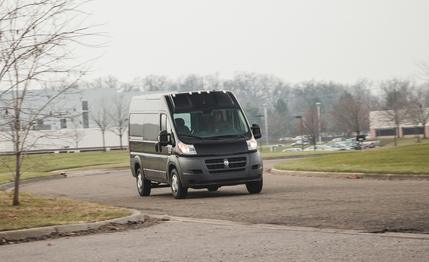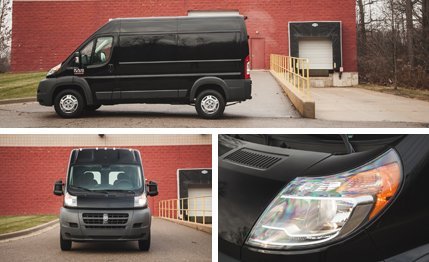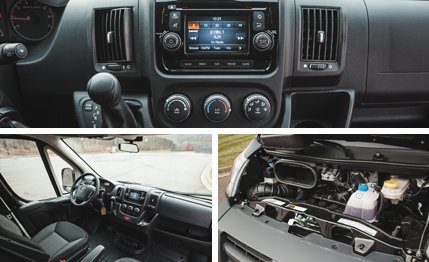
 Instrumented Test
TESTED
Instrumented Test
TESTED
Black is not a good hue for the Ram ProMaster 1500, not because black doesn’t look snappy, but a dark-colored commercial vehicle driven by uncommercial guys like us isn’t a good idea. The ProMaster is intended for contractors, plumbers, and other handy people who might otherwise buy a pickup but would appreciate the security and all-weather tidiness of hauling stuff under a roof. Let’s just say that sans work gear or cargo in the way back, or a prominently displayed business logo, we felt obliged to avoid schools and Chuck E. Cheese’s parking lots during our test.
With the mid-size 136.0-inch wheelbase and high-roof option (shorter- and longer-wheelbase versions are available), our test van’s footprint mirrored that of our long-term Ram 1500 pickup. But the Ram ProMaster 1500 has a space-saving front-wheel-drive layout, and unlike the rear-drive Mercedes-Benz Sprinter, Nissan NV2500/3500, and upcoming Ford Transit, the ProMaster has a low load floor. The front tires are spun by Chrysler’s 3.6-liter Pentastar V-6, whose 280 horsepower can yank the ProMaster to 60 mph in a segment-leading 8.1 seconds. The front-drive layout places a majority of the ProMaster’s weight over the front wheels, which will make some drivers feel more secure in poor-weather, low-traction situations.


Commercial Is as Commercial Does
The cockpit has the expected utilitarian look and hard plastics, although Ram—er, Fiat (this is a rebadged Ducato)—at least molded the petroleum jelly into somewhat attractive shapes. Life in our van was made more tolerable by Chrysler’s Uconnect infotainment system ($350) with an AM/FM tuner, navigation, and satellite radio. Our only gripe had to do with the driving position. Thanks to a buslike steering-wheel angle and a pedal-box design reminiscent of the Fiat 500’s—controls are actuated more by stepping down than pushing forward—it leaves the driver hunched over and his knees splayed, like a determined orangutan.
Passengers complained about the way the dashboard falls away to meet the expansive windshield, giving the sensation you could plunge through the glass, but we liked the wide-angle view out the front. Excessive dive and body roll, however, are hallmarks, and ride motions were generally not well checked. The 4909-pound (empty) utility box took a long—by car standards—199 feet to stop from 70 mph, and the numb and ultra-slow steering (3.9 turns lock-to-lock) required constant corrections on the highway and frantic arm flailing in the city. A confidence-inspiring driving machine the ProMaster is not.


Great for (Nonhuman) Cargo
Redemption came from loading up the gargantuan, 406-cubic-foot cargo hold with a ton of stuff and moving that stuff from one place to another. In back, you can stand tall without bonking your head, and the low lift-over height afforded by the front-drive layout makes loading and unloading a snap. Annoyingly, the unlock button on the key fob only opens the front doors (a security measure to keep unwanted cargo grabbers out); a separate button handles the rears, and the sliding side door in our test example didn’t shut if closed using only the handle. Closing it fully required a second hand pushing on the rear part of the door to engage the aft latch. Our test van came only with a passenger-side cargo door; adding a driver-side cargo door costs extra.
Which brings us to pricing. For the $34,820 our mid-level ProMaster commanded, we’d recommend buying a nicely spec’d Nissan NV2500 or, if your business had a really good year, stepping up to the more expensive Mercedes-Benz Sprinter. Either of those big-box vans feels more planted and maneuverable, whether being driven by normal guys past school zones or to a work site.